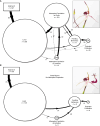Sexual attraction with pollination during feeding behaviour: implications for transitions between specialized strategies
- PMID: 37963103
- PMCID: PMC11005785
- DOI: 10.1093/aob/mcad178
Sexual attraction with pollination during feeding behaviour: implications for transitions between specialized strategies
Abstract
Background and aims: Understanding the origin of pollination by sexual deception has proven challenging, as sexually deceptive flowers are often highly modified, making it hard to resolve how any intermediate forms between sexual deception and an ancestral strategy might have functioned. Here, we report the discovery in Caladenia (Orchidaceae) of sexual attraction with pollination during feeding behaviour, which may offer important clues for understanding shifts in pollination strategy.
Methods: For Caladenia robinsonii, we observed the behaviour of its male wasp pollinator, Phymatothynnus aff. nitidus (Thynnidae), determined the site of release of the sexual attractant, and experimentally evaluated if the position of the attractant influences rates of attempted copulation and feeding behaviour. We applied GC-MS to test for surface sugar on the labellum. To establish if this pollination strategy is widespread in Caladenia, we conducted similar observations and experiments for four other Caladenia species.
Key results: In C. robinsonii, long-range sexual attraction of the pollinator is via semiochemicals emitted from the glandular sepal tips. Of the wasps landing on the flower, 57 % attempted copulation with the sepal tips, while 27 % attempted to feed from the base of the labellum, the behaviour associated with pollen transfer. A similar proportion of wasps exhibited feeding behaviour when the site of odour release was manipulated. A comparable pollination strategy occurs in another phylogenetically distinct clade of Caladenia.
Conclusions: We document a previously overlooked type of sexual deception for orchids involving long-distance sexual attraction, but with pollination occurring during feeding behaviour at the labellum. We show this type of sexual deception operates in other Caladenia species and predict that it is widespread across the genus. Our findings may offer clues about how an intermediate transitional strategy from a food-rewarding or food-deceptive ancestor operated during the evolution of sexual deception.
Keywords: Orchidaceae; Sexual deception; evolution; nectar; pollination.
© The Author(s) 2023. Published by Oxford University Press on behalf of the Annals of Botany Company.
Figures



Similar articles
-
A specialised pollination system using nectar-seeking thynnine wasps in Caladenia nobilis (Orchidaceae).Plant Biol (Stuttg). 2020 Mar;22(2):157-166. doi: 10.1111/plb.13069. Epub 2019 Dec 17. Plant Biol (Stuttg). 2020. PMID: 31705712
-
Pollination by nectar-foraging pompilid wasps: a new specialized pollination strategy for the Australian flora.Plant Biol (Stuttg). 2021 Sep;23(5):702-710. doi: 10.1111/plb.13286. Epub 2021 Jun 25. Plant Biol (Stuttg). 2021. PMID: 33998761
-
An experimental evaluation of traits that influence the sexual behaviour of pollinators in sexually deceptive orchids.J Evol Biol. 2018 Nov;31(11):1732-1742. doi: 10.1111/jeb.13370. Epub 2018 Oct 8. J Evol Biol. 2018. PMID: 30144355
-
Orchid pollination by sexual deception: pollinator perspectives.Biol Rev Camb Philos Soc. 2011 Feb;86(1):33-75. doi: 10.1111/j.1469-185X.2010.00134.x. Biol Rev Camb Philos Soc. 2011. PMID: 20377574 Review.
-
Mechanisms and evolution of deceptive pollination in orchids.Biol Rev Camb Philos Soc. 2006 May;81(2):219-35. doi: 10.1017/S1464793105006986. Biol Rev Camb Philos Soc. 2006. PMID: 16677433 Review.
Cited by
-
Plants, Pollinators and Pheromones: Promises and Lies of Semiochemicals.Plant Cell Environ. 2025 Sep;48(9):6865-6873. doi: 10.1111/pce.15670. Epub 2025 Jun 4. Plant Cell Environ. 2025. PMID: 40464418 Free PMC article. Review.
-
Pollination by sexual deception via pro-pheromone mimicry?New Phytol. 2025 Jun;246(6):2416-2424. doi: 10.1111/nph.70131. Epub 2025 Apr 10. New Phytol. 2025. PMID: 40211617 Free PMC article. No abstract available.
-
Cyclopogon guayanensis is an Unusual Orchid with a Generalistic Pollination System and Hexose Dominant Nectar.J Chem Ecol. 2025 May 28;51(3):62. doi: 10.1007/s10886-025-01611-4. J Chem Ecol. 2025. PMID: 40437101
References
-
- Ackerman JD, Phillips RD, Tremblay RL, Karremans A, Reiter N, Peter CI, Bogarín D, Perez-Escobar OA, Liu H.. 2023. Beyond the various contrivances by which orchids are pollinated: global patterns in orchid pollination biology. Botanical Journal of the Linnean Society 202: 295–324.
-
- Albuquerque NSL, Milet-Pinheiro P, Cruz DD, Navarro DMAF, Machado IC.. 2021. Pollination of the strongly scented Sarcoglottis acaulis (Orchidaceae) by male orchid bees: nectar as resource instead of perfume. Plant Biology 23: 719–727. - PubMed
-
- Alcock J. 1981. Notes of the reproductive behaviour of some Australian thynnine wasps (Hymenoptera: Tiphiidae). Journal of the Kansas Entomological Society 54: 681–693.
-
- Backhouse GN. 2018. Spider orchids: the genus Caladenia and its relatives in Australia. Melbourne: Gary Backhouse.
-
- Backhouse G, Bramwells H, Musker R, Walker G, Lester K.. 1999. Frankston Spider Orchid (Caladenia robinsonii G.W.Carr) recovery plan 1999-2003. Melbourne, Australia: Department of Natural Resources and Environment.
MeSH terms
Substances
Grants and funding
LinkOut - more resources
Full Text Sources
Miscellaneous

